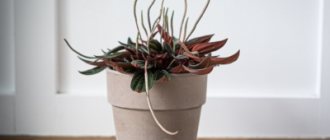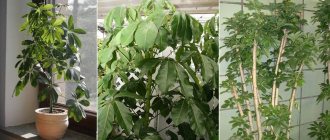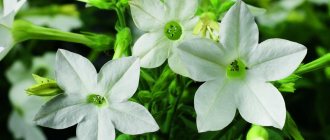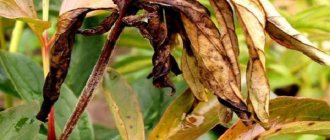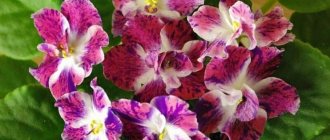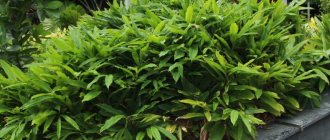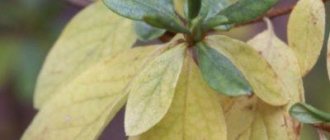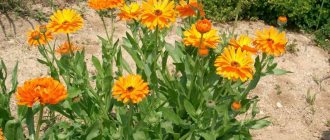Botanical description
Monstera is a large evergreen plant of the Araceae family.
Its natural habitat is Central and South America, and is found in Asia. Translated, the name of the plant means “bizarre.” This is a vine with a thick climbing stem, which is covered with aerial roots. The height of the plant reaches 5 m. Large leaf plates are attached to long petioles. The young leaves are whole, then holes and slits appear on them, and they become dissected into several lobes. The inflorescence is a spadix surrounded by a spathe.
Description of the plant
Monstera is an evergreen tropical crop of the genus Liana of the Araceae family, whose homeland is considered to be the southern regions of America. It has large, massive leaves in the shape of a heart with slits, the color of which is rich green, and may have spots, stripes of a lighter or yellow shade. Young leaves are devoid of slits: only with a certain age do they develop holes, which later transform into long slits.
The plant has a long stem from which roots can hang down. Under natural conditions, the height of an adult plant can reach 6 m, in domestic conditions - 4 m. It blooms in the form of a beige cob. After flowering is completed, it forms a fruit - a berry that is suitable for food. There are about thirty species of monstera in the world. In most cases, only a few are grown at home: monstera charma, lopsided or perforated.
Did you know? Many people mistakenly believe that the word “monstera” is translated as “monster, monster.” However, in fact, from Latin “monstrum” means “amazing, bizarre.”
Is it possible to keep Monstera at home?
How monstera blooms photo at home
Why you can: useful properties and signs
- Thanks to its large leaves, the monstera plant actively produces oxygen, evaporates moisture, thereby improving the microclimate in the room.
- The monstera flower actively purifies the air (absorbs electromagnetic radiation and formaldehyde evaporation).
- Monstera is recommended to be placed in offices, classrooms, and libraries. This is due to the fact that the energy of the plant has a beneficial effect on the nervous system: it puts thoughts in order, harmonizes the state of mind, helps to concentrate, and promotes informed decision-making.
- The plant also has a general strengthening effect on the body.
Why not
Monstera should not be placed in the bedroom, since photosynthesis occurs at night (oxygen is actively absorbed, which is unfavorable for a sleeping person).
How to care for monstera at home
How to care for monstera at home photo
The plant is unpretentious in care; you just need to create optimal conditions for its development.
Where to put it in the apartment
- Monstera does not like to be moved from place to place, so it is advisable to immediately choose a suitable location.
- Direct sunlight will leave burns on the leaves.
- It grows poorly in deep shade and may die.
- Provide sufficiently bright but diffuse lighting, perhaps only light shading.
Air temperature
The plant is comfortable with a temperature range of 16-24 °C, and the vine can easily tolerate sudden changes. If the temperature is low, the growth rate slows down.
Watering and spraying
In the warm season, water intensively and regularly. With the onset of cold weather, you should water moderately, avoiding drying out the earthen clod.
Spray monstera regularly. Periodically wipe the sheet plates with a damp soft cloth or sponge.
Monstera in winter
- It is advisable for the plant to ensure that the temperature is reduced to 14-18°C.
- Drafts (open windows) are not allowed.
- We reduce watering so that the soil has time to dry out a little.
- We stop spraying; it is better to place a container with damp moss or a humidifier nearby, and wipe the leaves with a damp sponge.
- Feeding is stopped.
Top dressing
During the period March-August, apply complex mineral fertilizers for decorative deciduous plants every 2 weeks. Adult vines can be fed with organic matter: once a season, cover the surface of the soil with humus or pour in infusion of fermented mullein in a concentration of 1:20.
What to do with aerial roots
Aerial roots are involved in additional nutrition and hydration. They don't look very attractive. They should be collected, tied to the trunk, wrapped in moss. When watering, moisten the moss - this will only benefit the vine.
About possible problems and ways to solve them
And finally, we present a table that shows the most common problems that arise in the process of growing monstera and suggests ways to eliminate them.
| Problem when growing | Cause | Remedy |
| Stunted growth, bare trunk | Keeping the plant in the shade | It is necessary to move the monstera to where it will receive bright but diffused light |
| Yellowed leaves | Lack of nutrition | The time has come to fertilize with fertilizers provided for this type of plant. |
| Leaves turn yellow and rot | Excessively frequent watering | It is necessary to adjust the watering regime |
| Monstera leaves “cry” - droplets of moisture form on their edges | Overwatering a plant | It is necessary to dry the soil and reduce the time between waterings |
| Pale leaf blades with yellow spots | Excess sunlight | Light control, location change |
| The edges of the leaves turn brown and resemble paper | Plant pots that are too tight or too dry air | Replanting or humidifying the air around the Monstera by spraying or wiping the leaves with a damp cloth |
As the monstera matures, it begins to shed its leaves. This is a natural process. But if the leaves dry out and turn brown before falling, this indicates that the air temperature is too high. The branches of an adult monstera are pruned to form a beautiful crown in order to preserve its decorative effect for as long as possible. Monstera should be protected from spider mites, scale insects and aphids, paying attention to keeping the plant clean and isolated from infected green “neighbors”. If pests do attack the monstera, they act according to the classical scheme and fight uninvited guests with the help of insecticides.
How to prune and replant monstera
With age, the vine becomes longer and leaves fall off the lower part of the trunk. The plant needs rejuvenation. It is necessary in the spring to completely cut off the top part, leaving about 30 cm. After some time, young shoots will appear. The top can be used for propagation: lower it into water, and when the roots grow (preferably, they completely fill the container), plant it in the soil.
- Replant young plants (up to the age of 4 years) annually, then replanting is required approximately once every 2-3 years.
- Increase the size of the pot each time you repot. The root system is powerful and requires space. Choose a deep, wide pot.
- The thickness of the drainage layer should be 1/3 of the container.
For planting, you can use a universal substrate, a mixture for palm trees, or prepare a soil mixture: turf and humus soil, peat, sand in equal proportions.
Soil composition requirements
The acidity level of the soil for a monstera should be neutral or slightly acidic - at its young age and more acidic - every year in adulthood (that is, with an increase in the amount of peat in the soil mixture). Each gardener has his own opinion on the choice of soil composition for this exotic plant, so you can choose from several options:
- 2 parts humus and one part each of peat, sand and turf soil;
- 2 parts of turf soil and one part each of sand, peat and humus;
- 3 parts of turf land and one part each of river sand and earth (deciduous);
- Everything is in equal proportions - coarse river sand, humus, turf soil, peat and deciduous soil.
Why do monstera leaves turn yellow, dry out and fall off?
Improper care negatively affects the appearance of the plant:
- Leaves dry out due to lack of moisture or nutrients.
- If the soil is waterlogged, the leaves begin to turn yellow, and the roots rot, an emergency replanting is necessary.
- The trunk of a young plant becomes bare, growth rates slow down - the lighting is insufficient.
- The edges of the leaf blades turn brown - the air is too dry or the root system is cramped in the pot.
- When exposed to direct sunlight, the leaves become covered with yellow spots.
- The leaf blades remain intact - the plant does not have enough light or nutrients.
- Due to increased air temperature, the leaves turn yellow and fall off (not to be confused with the natural gradual fall of leaves from the lower part of the trunk).
Proper transplantation of monstera
Replanting monstera involves replacing the top layer of soil, which should be done annually. To replant correctly, you need to buy a special soil composition. You can also create it yourself. To do this you will need humus, peat soil and sand. This mixture must be supplemented with turf.
If you have a fairly young plant, then you can leave it in a bucket for a year, but if the monstera is more than 3 years old, you need to transplant it into a pot. The ideal option for this is a wooden tub. The container cannot be too narrow or shallow. Since the plant will experience discomfort and grow poorly. Monstera requires mandatory support. We advise you to dig the trunk into the pot. It should have a height of approximately 1 m.
Transplanting monstera into another pot
Growing Monstera may attract some pests. It could be thrips. To protect yourself and the plant from this insect, you need to spray it with insecticides. You should also clean the leaves of pests with a soapy sponge. Caring for this plant is a lot of work, but in return you will receive a gorgeous flower that will make the air in your apartment clean and can decorate your home in an original way.
to contents ^
Why do monstera leaves turn black?
Monstera turns black due to stagnation of moisture in the pot, which can be caused by insufficient drainage and/or excessively frequent, abundant watering. The root system begins to rot, and the rot spreads to the entire plant.
An emergency replanting with soil replacement and fungicide treatment is required. Free the roots of the plant from the soil, cut off the rotten ones, and plant them in a disinfected pot with fresh soil. Do not forget to lay a drainage layer of small pebbles on one third of the pot. After transplanting, pour phytosporin solution and treat the leaves with it.
Problems in growing
If the rules of care are not followed, the plant may deteriorate in appearance:
- in low light, the monstera begins to shed its leaves and slows down in growth;
- lack of light can cause the plant to stretch and the leaves to shred;
- Leaf spotting occurs when a plant is damaged by spider mites;
- if the monstera does not have enough fertilizer, its leaves may turn yellow;
- the second reason for yellowing of leaves is stagnation of moisture in the soil;
- with insufficient watering, the foliage begins to dry out and darken, this may also be a sign of a cramped pot;
- too bright light makes monstera leaves pale, and yellowish spots may appear on them;
- the absence of cuts in adult leaves indicates a lack of nutrition and light;
- Among the pests, aphids and scale insects may appear.
How to propagate monstera at home
How does monstera reproduce? This plant is sometimes propagated by seeds, but mainly vegetatively.
Growing monstera from seeds
Monstera seeds photo
- To sow seeds, fill the container with light, water- and breathable soil.
- Plant the seeds shallowly, at a distance of 4-5 cm, moisten the crops, cover with transparent glass or film.
- Maintain the air temperature at 25 °C.
- Ventilate the greenhouse regularly and moisten the soil.
- Shoots will appear in about a month.
Monstera from seeds photo seedlings
- Plant the grown seedlings in separate pots.
- At first there will be only juvenile, undissected leaves; after 5-8 months of growth, real dissected leaf blades will appear.
Propagation of monstera by cuttings
How to cut a monstera cutting photo
- Can be propagated by apical and stem cuttings.
- Do this in spring time.
- The cutting must contain one node and at least one mature leaf, preferably an aerial root primordium.
- Make the upper cut above the kidney, it should be straight, the lower cut should be oblique.
- Root into the soil. The unit should be immersed halfway in the ground.
- Cover with a jar or plastic bottle and water through a tray.
- With the appearance of young shoots, they can be replanted separately.
Reproduction by lateral shoots and rhizome division
Reproduction of monstera by lateral shoots
Lateral shoots appear at the bottom of the stem - root them in spring. The shoot must have aerial roots and leaves. They can be planted immediately in separate pots.
When transplanting adult plants, the rhizomes can be divided. Each division must contain part of a rhizome, a full-fledged leaf rosette or a growth bud. Place in separate containers.
Types of monstera with photos and names
Monstera adansonii monstera adansonii
Monstera Adansonii monstera adansonii variety swiss cheese vine photo
It can reach a height of about 8 m. The length of the leaf plate is 20-55 cm, width - 15-40 cm. They are ovoid in shape, covered with holes. Flowering: spadix surrounded by a yellowish veil.
Monstera Borsiga monstera borsigiana
Monstera deliciosa borsigiana Variegated photo
The cyst plates are heart-shaped, evenly incised, and painted dark green.
Monstera pierced or full of holes Monstera pertusa
Monstera pierced or full of holes Monstera pertusa photo
The length of the leaf plates can reach 1 m, they are dotted with holes of various shapes.
Monstera deliciosa or attractive Monstera deliciosa
Monstera deliciosa or attractive Monstera deliciosa photo
The leaf blades are heart-shaped, pinnately dissected, and covered with holes. The peculiarity is that this species bears fruit. After flowering, a soft berry appears that tastes like pineapple. Fruit ripening lasts about 10 months (at home).
Monstera oblique or unequal-sided Monstera Obliqua
Monstera oblique or unequal-sided Monstera Obliqua photo
Climbing liana. The ellipsoidal leaf plates are covered with large oblong-shaped holes, the edges are solid. The halves of the leaf are slightly different in size: one is larger than the other, which is where the name comes from.
Monstera Karvinskyi Monstera karvinskyi
Monstera Karvinskyi Monstera karvinskyi photo
The height of the plant reaches 3 m. The young leaves are whole, then they are cut into blades, and holes appear on them.
Monstera acuminata
Monstera acuminata photo
The leaf blades are solid with pointed tips; over time, holes appear in them.
9 Comments on “Monstera houseplant Care at home Reproduction and replanting Photos of species”
I saw it in natural conditions on the island of Sri Lanka. Very beautiful liana! It's a pity that you can't attach a photo to a comment.
Hello Irina! We have added this feature especially for you. We will be glad to see your photos! Just refresh the page by holding down the Shift key to see the image upload form.
How amazing! I am attaching a photo
